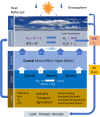Climate changes affecting global iodine status
- PMID: 38471306
- PMCID: PMC11046319
- DOI: 10.1530/ETJ-23-0200
Climate changes affecting global iodine status
Abstract
Global warming is now universally acknowledged as being responsible for dramatic climate changes with rising sea levels, unprecedented temperatures, resulting fires and threatened widespread species loss. While these effects are extremely damaging, threatening the future of life on our planet, one unexpected and paradoxically beneficial consequence could be a significant contribution to global iodine supply. Climate change and associated global warming are not the primary causes of increased iodine supply, which results from the reaction of ozone (O3) arising from both natural and anthropogenic pollution sources with iodide (I-) present in the oceans and in seaweeds (macro- and microalgae) in coastal waters, producing gaseous iodine (I2). The reaction serves as negative feedback, serving a dual purpose, both diminishing ozone pollution in the lower atmosphere and thereby increasing I2. The potential of this I2 to significantly contribute to human iodine intake is examined in the context of I2 released in a seaweed-abundant coastal area. The bioavailability of the generated I2 offers a long-term possibility of increasing global iodine status and thereby promoting thyroidal health. It is hoped that highlighting possible changes in iodine bioavailability might encourage the health community to address this issue.
Keywords: atmospheric; climate change; global warming; iodine; thyroid.
Conflict of interest statement
The authors declare that there is no conflict of interest that could be perceived as prejudicing the impartiality of the study reported.
Figures

Similar articles
-
Iodine, Seaweed, and the Thyroid.Eur Thyroid J. 2021 Apr;10(2):101-108. doi: 10.1159/000512971. Epub 2021 Jan 27. Eur Thyroid J. 2021. PMID: 33981614 Free PMC article. Review.
-
Changes in tropospheric composition and air quality due to stratospheric ozone depletion and climate change.Photochem Photobiol Sci. 2007 Mar;6(3):301-10. doi: 10.1039/b700022g. Epub 2007 Feb 6. Photochem Photobiol Sci. 2007. PMID: 17344964
-
Air quality and climate connections.J Air Waste Manag Assoc. 2015 Jun;65(6):645-85. doi: 10.1080/10962247.2015.1040526. J Air Waste Manag Assoc. 2015. PMID: 25976481 Review.
-
Climate changes modulated the history of Arctic iodine during the Last Glacial Cycle.Nat Commun. 2022 Jan 10;13(1):88. doi: 10.1038/s41467-021-27642-5. Nat Commun. 2022. PMID: 35013214 Free PMC article.
-
Does iodine gas released from seaweed contribute to dietary iodine intake?Environ Geochem Health. 2011 Aug;33(4):389-97. doi: 10.1007/s10653-011-9384-4. Epub 2011 Mar 23. Environ Geochem Health. 2011. PMID: 21431377
Cited by
-
Climate change induced atmospheric iodine enrichment - a paradoxically beneficial contribution.Adv Nutr. 2025 Jun;16(6):100437. doi: 10.1016/j.advnut.2025.100437. Epub 2025 Apr 29. Adv Nutr. 2025. PMID: 40311935 Free PMC article. No abstract available.
References
-
- IPCC. Climate change 2022: impacts, adaptation and vulnerability . Working group II contribution to the IPCC sixth assessment report. 2022.
-
- UN Environment Programme. (Available at: https://www.unep.org/news-and-stories/video/global-warming-far-exceed-pa..., https://www.unep.org/resources/emissions-gap-report-2023)
-
- Wadley MR Stevens DP Jickells TD Hughes C Chance R Hepach H Tinel L & Carpenter LJ. A global model for iodine speciation in the upper ocean. Global Biogeochemical Cycles 202034 e2019GB006467. (10.1029/2019GB006467) - DOI
-
- Sherwen T Evans MJ Carpenter LJ Schmidt JA & Mickley LJ. Halogen chemistry reduces tropospheric O3 radiative forcing. Atmospheric Chemistry and Physics 2017171557–1569. (10.5194/acp-17-1557-2017) - DOI
Publication types
MeSH terms
Substances
LinkOut - more resources
Full Text Sources
Medical

